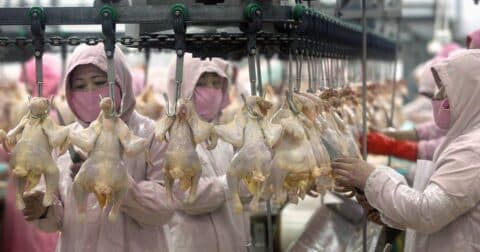Explainer
How Overconsumption Affects the Environment and Health, Explained
Climate•12 min read
Investigation
Development banks are scaling factory farming in the places already worst hit by climate change.


Words by Sophie Kevany
Fifteen development banks and a fund tasked with supporting sustainable economic growth are investing billions of dollars to expand factory farming in the global south and other lower income countries, a new analysis from the non-profit Stop Financing Factory Farming finds. The lower income countries where banks are funding industrial agriculture are often the same countries that are more vulnerable to the extreme weather linked to climate change, which itself is fueled by industrial meat and dairy operations. The analysis finds 15 banks and one fund, including the World Bank Group and the United Nations’ Green Climate Fund, invested just over $3 billion on animal agriculture in 2023, with over three quarters of the funded projects described by the researchers as factory farms. Another $3.4 billion was marshaled from other private and public funders.
Factory farms are responsible for between 11 and 20 percent of global greenhouse emissions, as well as a host of other impacts like water pollution, pandemic risks and animal suffering. The analysis is based on data from a civil society database called the Early Warning System, which collects funding information from project websites.
A number of climate models predict populations in developing countries will consume more meat as incomes increase, yet the new analysis finds the investments from development banks encourage the production of feed crops for farm animals, not humans, worsening food insecurity. Many of those animals are exported: a 2021 paper found developing countries provide nearly 80 percent of international poultry exports by volume, for instance.
“These investments often generate negative consequences for local communities and for animal welfare… [creating] hurt at many levels, locally, globally and for the environment, the climate, people and animals,” Alessandro Ramazzotti, a researcher with the International Accountability Project, tells Sentient. The International Accountability Project is a member of the Stop Financing Factory Farming coalition.
Factory farm investments hurt the financiers themselves, as well, Ramazzotti says. “Development banks have climate change goals and if they keep investing in animal agriculture, especially when this is industrial, large-scale, they are not going to meet those commitments.”
This tension is especially clear at the World Bank Group, the largest development investor by volume in factory farming projects. The bank says it is aligned with the Paris climate agreement goal of keeping warming to 1.5 degrees Celsius. It also published a report suggesting subsidies be redirected away from “emissions-intensive, animal-source foods,” which account for almost 60 percent of total food-related emissions.
Despite its climate goal and the report, one of the World Bank’s members, the International Finance Corporation, invested $501 million in factory farming in 2023, including a $47 million loan for a multi-story pig farm, the analysis finds.
A statement from the International Finance Corporation reads in part: “Animal protein is important for nutrition, especially in several of our client countries where early childhood and maternal undernutrition and micronutrient deficiencies remain pervasive and animal-source foods consumption is far below the recommended amount. There are 1.3 billion people whose livelihoods are tied to livestock and we also know this sector is responsible for over 30 percent of the global GHG emissions…IFC works with livestock clients that are committed to enhancing animal health and welfare, protecting the environment, and promoting food safety…By investing in sustainable solutions that intensify production and improve efficiency in livestock operations, it is possible to reduce global GHG emissions and eliminate deforestation in direct and sourcing operations while providing affordable and safe food in emerging markets.”
In the past several years, analysts for development banks have also argued for shifts from large-scale beef operations to pork and poultry, citing the lower emissions associated with these foods. A 2021 document drafted by the European Investment Bank, described non-ruminant meat — essentially pork and poultry farms — as a climate-friendly investment option. Last year, the same bank invested $427 million in factory farming, the new analysis says.
Shifting factory farms from one animal to another because they produce lower emissions does not make it a good idea, says Ramazzotti. “In the case of the multi-story pig farm in China, that is supposed to limit the environmental impact, yes, but then what about animal welfare?” There are other impacts to consider, Ramazzotti adds. “Farms like that are a big risk for human health, because they are a great place for viruses to develop.”
A spokesperson for the European Investment Bank responded in part that “EIB Group’s lending policies for farming, agriculture and the bioeconomy are fully aligned with the EU’s strict legal framework, including European Green Deal policies, as well as with legislation regarding animal welfare.” The full statement is here.
The spokesperson also criticized the report’s characterization of some projects as “entirely unrelated to animal production.”
In an email to Sentient, Ramazzotti provided a specific description of each of these projects, and responded more generally: “those three projects have been included because the EIB’s project disclosures are among the worst of all MDBs in terms of transparency — and therefore one of the most challenging institutions to analyze and hold accountable.” The full response is here.
The contradiction between climate goals and climate investments are not unique to development banks. The United Nations has reported that animal agriculture is a disproportionate threat to biodiversity and the environment, and that eating more plants would reduce those threats, improve human health and lower the risk of pandemics. Meanwhile, the United Nations’ Green Climate Fund, an initiative that aims to help reduce greenhouse gas emissions in developing countries, invested $175 million on industrial animal agriculture last year, the analysis finds.
In Mongolia, Ramazzotti highlighted the irony of development bank funding for an industrial cattle project in a country already suffering from extreme weather known as the dzud. The dzud is characterized by dry summers and freezing winter temperatures, heavy snow and frozen ground. “And here, the International Finance Corporation is proposing an investment in an industrial cattle farm. As I understand, the investment is not likely to benefit, or only marginally, local people and it will increase the pesticides on feed crops and the methane produced by cattle, plus the farm is near a coal producer, and in a valley, which makes everything worse for the local people,” he says.
Stop Financing Factory Farming is asking the financiers to stop funding industrial livestock operations at this scale, and instead shift investments toward farming systems that put “communities first and protect the planet.”
In response to Sentient’s request for comment on the report, the United Nations, the Green Climate Fund and the African Development Bank did not immediately comment on the analysis.
Yet a change of direction is entirely possible, the analysis finds, citing the same Green Climate Fund for supporting some low-carbon projects. One example is a fund to help women farmers in Cote D’Ivoire adapt to climate change in a variety of ways, including boosting financial literacy and knowledge of land rights.